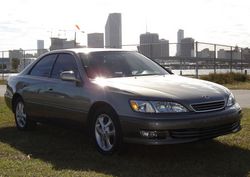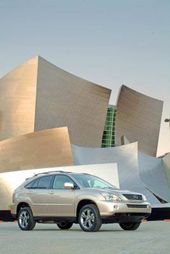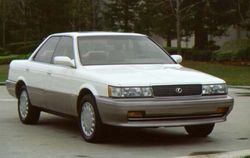.
Lexus ES
 The Lexus ES series is a family of mid-size sedans produced by the Lexus division of Toyota from 1989 to the present and built in Tsutsumi, Japan. The series has always been built off of the Toyota Camry platform with a V6 engine and automatic transmission. For long, it had been Lexus's entry-level car, competing with the Infiniti G20, I30 and Acura TL until the arrival of the Lexus IS in 2001. The ES 250, built from August 30, 1989 until July 5, 1991, shared the body style of the contemporary Camry, while the Toyota Windom, a Japan-only model, shared the ES's body style from the second generation onwards. The fifth-generation ES 350 was unveiled in the spring of 2006 as a 2007 model, and is a major redesign.
The Lexus ES series is a family of mid-size sedans produced by the Lexus division of Toyota from 1989 to the present and built in Tsutsumi, Japan. The series has always been built off of the Toyota Camry platform with a V6 engine and automatic transmission. For long, it had been Lexus's entry-level car, competing with the Infiniti G20, I30 and Acura TL until the arrival of the Lexus IS in 2001. The ES 250, built from August 30, 1989 until July 5, 1991, shared the body style of the contemporary Camry, while the Toyota Windom, a Japan-only model, shared the ES's body style from the second generation onwards. The fifth-generation ES 350 was unveiled in the spring of 2006 as a 2007 model, and is a major redesign.
First generation (1989-1991)
In order to avoid introducing the nameplate with only one model, the LS400, Lexus debuted the ES alongside their flagship sedan. The first ES (codename VZV21) was introduced in 1989 as the ES 250, powered by the Camry's 2.5 L, 156 hp V6. The ES 250 was based on the Toyota Vista—a model never sold in the United States—which in turn shared the body and chassis of the Toyota Camry. Due to its similarities to the Camry, the ES 250 was viewed as a product of badge engineering and did not sell as well as its less expensive counterpart.
|- |Template:Infobox Automobile generation
Second generation (1992-1996)
Assembly of the ES 300 commenced on September 9, 1991. Completely redesigned for the 1992 model year and now based on the VCV10-series Toyota Windom, the model was renamed the ES 300 to reflect the half-liter bump in engine displacement. This second generation was significantly larger and more curvaceous than its predecessor and sported a 197 hp engine. In Japan, a 172 hp, 2.5 L version of the Windom (VCV-11) was made available in 1992. The 1993 ES 300 was the last Lexus sedan to offer a 5-speed manual transmission until the introduction of the IS 300.
|- |Template:Infobox Automobile generation
Third generation (1997-2001)
The third generation (designated MCV20) appeared in 1997 with a 200 hp 3.0 L V6 and a 197 hp, 2.5 L V6 in the Windom. The new cars featured a design that was an evolution of the VCV10, and possessed a more rakish profile, sharper body lines, reflector instead of projector headlights, and a more upscale interior. The new ES was also slightly longer but weighed less than the previous generation. The power rating would grow to 210 hp in 1999, and the model would receive a mild facelift in 2000.
|- |Template:Infobox Automobile generation
Fourth generation (2002-2006)
A year after the Lexus IS became Lexus's entry-level car, a larger, fourth generation ES (designated MCV30) debuted in 2002. The presence of the IS in the Lexus lineup enabled the company to give the ES a more upscale image and luxury feel by excising the sporting pretentions of the previous ES models. Compared to its predecessor, the new ES possessed a more luxurious interior, superior NVH isolation, larger, plusher seats, and improved interior materials. Nevertheless, despite the luxury enhancements, neither the acceleration nor the handling of the ES suffered. Other new features included a drive-by-wire electronic throttle, a five-speed automatic transmission, anti-lock brakes with electronic brake-force distribution and brake assist as well as stability and traction control. In Japan, the MCV30 Windom received a 2-star LEV rating.
For the 2003 model year, the US and European markets received a new 3.3 L engine producing 225 hp (later revised to 218 hp), and the car was renamed ES 330. In the Middle Eastern and Asian markets, however, the 3.0 L engine was still available. In 2005, the ES received a facelift with new front and rear fascias, clear taillights, projector headlights, and a redesigned grille. Inside, several new-for-the-ES features included power adjustable pedals, heated and ventilated front seats and rearview mirrors that would automatically tilt downward in reverse gear. Additionally, new bird's-eye maple trim brightened the interior and integrated satellite radio was offered as an option.
|- |Template:Infobox Automobile generation
Fifth generation (2007)
The fifth generation ES debuted at the Chicago Auto Show in February of 2006. It arrived at dealerships in late April, 2006 as a 2007 model.
The new ES, now called the ES 350, features the first use of a six-speed automatic transmission in a front wheel drive Toyota vehicle along with its sister car, the Toyota Camry V6. The engine is the 272 hp (203 kW) aluminum 3.5 L 2GR-FE V6 engine with variable valve timing. Toyota estimates that this combination will accelerate to 60 mph (97 km/h) in less than 7 seconds. Fuel economy is estimated at 21 mpg (11.2 L/100 km) in the city and 30 mpg (7.8 L/100 km) on the highway.
New features include a three-panel glass sunroof, radar-based adaptive cruise control, and a parking-assist warning system. A keyless entry and ignition system which does not require the electronic remote to be taken out of the driver's pocket is now standard.
|}

| ||
| LEXUS | ||
|
Toyota | Lexus | Scion | Hino | Daihatsu Current Cars: IS 250/250C/350 · IS-F · ES 350 · GS 300/430/450h · LS 460/460L · LS 600h/600hL · LFA · CT 200h SUVs: RX 330/350/400h · GX 460 · LX 470 · LX 570 Hybrid: RX 450h · GS 450h · LS 600h/600hL · HS 250h Historic Cars: IS 200/300 · ES 250/300/330 · GS 300/400/430 · LS 400/430 · SC 300/400/430 Hybrid: RX 400h Racing Vehicles Concept Vehicles LF-A Concept · LF-C Concept · LF-Ch Concept · LF-S Concept · LF-Sh Concept · LF-X Concept · LF-Xh Concept · IS 250 Sports Concept | ||
| Toyota | Corporate website | A division of the Toyota Motor Corporation |

